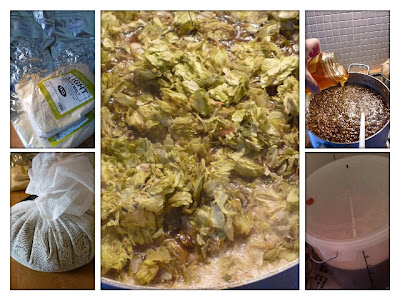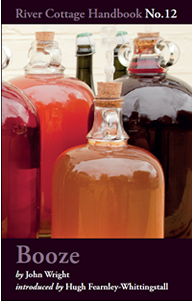Brew Day
Ingredients arrived from the Brew UK store and I’m ready to home brew. I’d put aside a full weekend, especially if it’s your first of a few brews. Start early, well before midday at least then it gives you some daylight hours to take your time. You will need to sterilise all the equipment you use on brew day and make sure you wash thoroughly after otherwise you could risk cleaning fluid taste in your brew and a very unpleasant flavour. It’s also an idea to download a few podcasts or pull together the longest playlist you can as you’ll need a few hours of music to keep you going. I’d been saving a load of Stones Throw Records and Bill Brewster’s DJ History podcasts that I’d downloaded, and then forgotten to listen to over the last few months.
I decided to brew the extract version I had purchased of the honey porter first instead of the all grain method pack as I thought it would be a good idea to start with something simpler (as I hadn’t brewed for a few months). The good people at Brew UK had scrutinised Obama’s White House recipe and handily put together all the malts and hops you need to have a good attempt at brewing a matching presidential beer.
First up I heated six litres of water in a large pan to between 65-70 degrees centigrade and then added the grain pack. It’s a good idea to buy some muslin and place the grains in and tie like a big teabag (not too tight). It makes removing them far easier than just relying on straining later on. I left this to infuse for 30 minutes (with the pan lid on) and you could really start to see where the colour comes from as the water began to turn chocolaty brown. The malts in the pack were munich, chocolate, crystal and black variants. I then removed the grain teabag and put to one side. Remember you need to try and keep the bad bacteria out whichever way you can (covering the liquid at all points), as if they drop in they could multiply and create bad flavours.
Next I added the malt extract into the liquid (this is now known as the wort) and brought to the boil for 15mins; adding the first hop pack and boiling for a further 15 minutes. I then added the second hop pack – both are for the bittering flavour components of the beer and boiled for 30 minutes. The hop packs consisted of Hallertauer and Goldings varietals. In the last 5 minutes I added the honey which was a jar of clear good quality honey (roughly 500g). I turned off the heat and allowed the liquid to cool to 80 degrees centigrade and finally added the third hop pack for the aroma component and allowed to steep for 30 minutes (with the pan lid on again, remember keep those bad bacteria out!).
I filled the fermenting bin up with 8 litres of cold water and strained the cooled boiled wort into the water, this can be difficult to do with one person so I’d say grab a friend to help. If you can try to do as close to the liquid in the bin as you can so as to get as little additional air into the mix as possible. I then topped up the fermenting bin to 19 litres, pouring the remaining water through a strainer to extract maximum flavour from the hops. The yeast pack I received required rehydrating which basically means mixing up with sterilised water. I just followed the instructions on the back of the packet and used some boiled water from the kettle I had put aside (covered) from earlier, so it had cooled to the required temperature. When the wort had cooled to between 16-24 degrees centigrade I added the re-hydrated yeast. Throughout it’s best to use a thermometer to check the necessary temperature for each step.
As I’m not yet at this stage I’ll run down a quick guide to the racking. I find it much easier to use a racking bucket as I like to use bottles as my secondary fermenting vessel:
• Make a priming syrup by mixing sterile water and sugar; bring to a boil for five minutes. Pour the mixture into your empty bottling bucket. This will mean the remaining yeast in the wort will consume this sugar and start a small refermentation in each bottle. This gives natural bubbles to your beer as carbon dioxide produced remains dissolved in the beer and makes it ‘bottle conditioned’. Depending how much wort you have made I would do a quick search on the internet to find the relevant mix/amount of sugar required. The Brew UK site gives a good guide and also mentions barrel options if you decide to go for that instead.
• Siphon the beer from the fermenter into the racking bucket. This is where you’ll use your racking cane and again make sure you’ve pre-sterilised all your equipment and rinsed thoroughly. It helps to lift the fermenting bin onto a higher work surface to enable gravity to do its part of the job.
• Use a long spoon to mix and distribute priming sugar evenly throughout the beer.
• Fill up your bottles via the racking bucket’s dispenser.
• Crown all the bottles with your bottler capper (again sterilise the crowns).
• Place bottles in box with lid and store at room temperature.
• Wait roughly 2 weeks for your beer to clear before sampling your first beer! When you pour, leave the yeast sediment behind in the bottle.
For troubleshooting, hints and tips the ‘Brew Your Own’ site is really useful and I’d advise having a read before your first brew.
If you fancy having a go at brewing the previous winner of Thornbridge and Nicholson’s pubs ‘Great British Home Brew’ competition you can purchase either the extract version or the all grain pack from Brew UK. ‘Frank as Apollo’ a 4.6% abv premium bitter using Apollo and Celeia hops was the winner.
Hopefully in 2 weeks I’ll have my own Honey Porter ready to drink, just in time for Christmas. I thought of calling it ‘The Everly Exposed Honey Porter’ as a bit of a nod to Sheffield local legends The Everly Pregnant Brothers and their upcoming Christmas Hoedown. I’m open to suggestions for names, so drop me a line……
Update! I called it 'Sips Honey Porter'








Comments